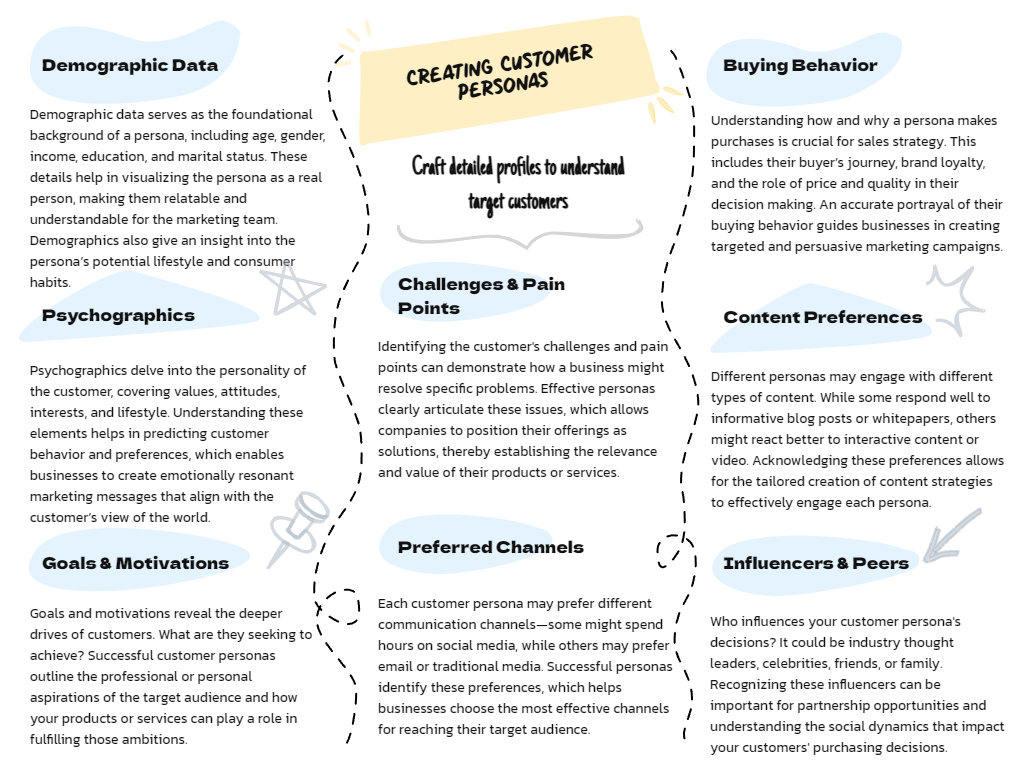Crafting Effective Marketing Campaigns: A Step-by-Step Guide
February 27th, 2024

When considering that 65% of marketers struggle with generating traffic and leads, you might wonder how to navigate the complexities of crafting effective marketing campaigns.
By understanding the key steps involved in creating a successful campaign, you can unlock the potential to reach your target audience effectively and drive meaningful results.
By implementing a strategic approach and focusing on essential elements, you can set yourself up for success in the ever-evolving landscape of marketing.
Key Takeaways
- Define specific objectives aligned with business goals.
- Identify target audience through demographics and behaviours.
- Select channels based on audience activity and receptiveness.
- Analyse performance data to optimize campaign effectiveness.
Defining Campaign Objectives
To kickstart your marketing campaign effectively, begin by clearly defining your campaign objectives to steer your strategy in the right direction. Your marketing campaign’s success hinges on setting specific and measurable objectives that align with your overall business goals.
Whether your aim is to boost brand awareness, drive sales, launch new products, or foster customer loyalty, having well-defined objectives is crucial.
These objectives serve as the guiding light for your entire campaign, helping you craft a compelling message that resonates with your target audience.
Identifying Target Audience
Analyse demographics, psychographics, and behavioural characteristics to effectively identify your target audience for precision in tailoring marketing messages and offers. Understanding your market through detailed market research is essential to pinpointing the demographics that make up your audience, such as age, gender, income, and location.
Psychographics delve into the personalities, values, interests, and lifestyles of your potential customers, providing valuable insights into their motivations and preferences.

By examining behavioural characteristics like buying habits and decision-making processes, you can create personalized marketing strategies that resonate with your audience on a deeper level.
Successful audience segmentation allows you to tailor your campaigns to specific groups within your target audience, increasing the relevance of your messages and driving engagement.
This precision in identifying your target audience is key to maximizing campaign effectiveness and achieving desired outcomes. By focusing on understanding who your audience is and what drives them, you can create marketing campaigns that truly connect and resonate with the people you aim to reach.
Selecting Key Channels
To effectively select key channels for your marketing campaign, consider the following key factors:
- Targeted audience selection
- Assessing the compatibility of channels with your message
- Strategically allocating resources for cost-effective reach
Targeted Audience Selection
When targeting your audience and selecting key channels, consider where they’re most active both online and offline. Understand your target audience’s preferences and behaviours to choose the right channels—such as social media platforms, influencer partnerships, and traditional advertising—that resonate with them.
Crafting an engaging message tailored to your audience on these channels is crucial for effective engagement and campaign success. By selecting the channels where your audience is present and receptive, you increase the likelihood of reaching them at the right time with the right content.
Utilizing a mix of online and offline channels based on your audience’s habits ensures a comprehensive approach to connecting with them and driving conversions.
Channel Compatibility Assessment
Considering your target audience’s preferred channels is paramount when selecting key channels for your marketing campaign, ensuring effective communication and engagement.
To make the most out of your channel selection process, remember to:
-
Analyze Data: Utilize market research and analytics to assess the target audience’s preferred channels effectively.
-
Align with Campaign Goals: Evaluate the compatibility of channels like social media, email, content marketing, and traditional advertising with your campaign objectives.
-
Optimize Performance: Continuously track performance metrics to optimize channel selection and enhance overall campaign effectiveness.
Cost-Effective Channel Allocation
Maximizing your marketing budget’s impact involves strategically allocating resources across key channels to achieve optimal ROI. Utilize data-driven analysis to identify the most cost-effective channels for reaching your target audience.
Consider factors such as audience demographics, channel effectiveness, and campaign goals when selecting these key channels. Tools like Google Analytics, social media insights, and market research are invaluable in informing your channel allocation decisions.
Testing and optimizing channel performance will help refine your strategies for better cost-effectiveness over time. By focusing on cost-effective channels that resonate with your target audience, you can ensure that your marketing budget allocation generates the best possible return on investment.
Assigning Roles and Tasks
When assigning roles and tasks in your marketing campaign, consider task delegation strategies, the importance of role clarity, and effective communication channels.
By strategically assigning specific tasks to team members based on their strengths, you maximize productivity and campaign performance.
Clear accountability and well-defined roles contribute to successful implementation of your marketing strategy.
Task Delegation Strategies
To enhance the efficiency and effectiveness of your marketing campaign, strategic task delegation is crucial for assigning roles and responsibilities to team members based on their strengths and expertise.
Effective task delegation in marketing campaigns leads to streamlined processes, improved accountability, and successful campaign outcomes.
Here are essential strategies for task delegation:
- Utilize Team Expertise: Assign tasks based on individual strengths to maximize efficiency.
- Establish Clear Communication Channels: Regularly communicate roles, expectations, and progress updates for seamless coordination.
- Encourage Accountability: Ensure team members take ownership of their tasks to meet campaign objectives effectively.
Role Clarity Importance
Enhance your marketing campaign’s efficiency and effectiveness by clearly defining roles and tasks to ensure accountability and streamline coordination among team members.
Target defined roles for each team member to maximize efficiency and productivity. Assigning responsibilities based on individual strengths and expertise will optimize each member’s contribution to the campaign.
When roles are clearly outlined, team members understand their tasks, reducing confusion and minimizing duplication of efforts. This clarity fosters better communication and collaboration among team members, leading to a smoother workflow.
Effective Communication Channels
Maximizing team efficiency and fostering collaboration in marketing campaigns hinges on establishing effective communication channels for assigning roles and tasks. When it comes to role assignment and task delegation, clear responsibilities are key to maximizing efficiency and ensuring smooth team coordination.
By streamlining communication through effective channels, you can enhance information flow and promote seamless collaboration among team members. This not only aids in the decision-making processes but also contributes to the overall success of the campaign.
Make sure to designate roles thoughtfully, considering each team member’s strengths and expertise to create a well-rounded and effective marketing strategy. Effective communication channels are the backbone of successful campaigns, facilitating a cohesive and productive workflow.
Setting Campaign Budget
Allocate your campaign budget strategically by aligning it with your goals, target audience, and desired outcomes to ensure effective resource utilization.
Setting a campaign budget involves determining how much to allocate to different marketing activities such as advertising, promotions, and content creation.
It’s crucial to consider costs for various marketing channels like social media, paid advertising, influencer partnerships, and offline promotions during budget planning.
Monitoring and adjusting the budget as needed throughout the campaign can help optimize spending and maximize ROI based on performance data and results.
Blue-collar entrepreneurs, especially those facing financial constraints, should follow a well-defined budgeting process to make informed decisions.
By adhering to a carefully structured budget, you can enhance the likelihood of achieving successful marketing outcomes within your means. Remember, a well-thought-out budget is a key component in the overall success of your marketing campaign.
Calculating Expected ROI
To ensure the success of your marketing campaign, understanding how to calculate the expected ROI is crucial in evaluating its effectiveness and profitability.
Expected ROI is determined by subtracting the campaign costs from the revenue generated. This calculation provides insight into the campaign’s profitability and helps in making informed decisions for future strategies.
Expressing ROI as a percentage by dividing the net profit by the total cost and multiplying by 100 adds clarity to the financial performance of your efforts.
Forecasting potential revenue accurately and estimating costs diligently are essential steps in deriving a reliable expected ROI figure.
Monitoring and analyzing the actual ROI against the expected ROI post-campaign launch is vital for understanding the campaign’s success and areas for improvement. By following these steps, you can confidently assess the financial impact of your marketing initiatives and optimize your strategies for enhanced profitability.
Establishing Campaign Timeline
Establish a well-defined campaign timeline to streamline tasks, prioritize effectively, and meet crucial deadlines for successful execution. By outlining a detailed timeline, you can ensure that each step of your marketing campaign is completed efficiently.
Setting specific milestones within the timeline is crucial for tracking progress and making necessary adjustments along the way. Consider incorporating seasonal trends and consumer behavior patterns into your schedule to optimize the timing of your campaign launch for maximum impact.
Moreover, a well-structured timeline fosters team coordination, promoting smooth communication and enhancing overall campaign efficiency. Make sure to allocate ample time for each task, allowing for flexibility while still adhering to deadlines.
Frequently Asked Questions
How Do You Create a Marketing Campaign Step by Step?
To create a marketing campaign step by step, understand your target audience, tailor brand messaging, utilize visual content effectively, engage on social media, leverage email marketing, strategize advertising, craft compelling content, analyze data, track campaign performance, and allocate budget wisely.
What Are the 7 Steps to Creating an Effective Marketing Plan?
To create an effective marketing plan, begin by defining your target audience, crafting a compelling messaging strategy, establishing strong brand positioning, conducting competitive analysis, allocating budget wisely, creating engaging content, planning media placements, executing campaigns, tracking metrics, and optimizing campaigns for success.
What Are the 5 Essential Parts of a Marketing Campaign?
To craft a successful marketing campaign, focus on goals, brand messaging, creative content, call to action, and target audience. Allocate budget wisely, analyze campaign performance, leverage social media, influencer partnerships, email marketing, and track data for optimal results.
What Are the 6 Steps Needed for a Successful Campaign?
To run a successful campaign, focus on your target audience, craft compelling brand messaging, create engaging visual content, utilize social media effectively, include strong calls to action, track analytics, leverage email marketing, consider influencer partnerships, use paid advertising, and engage in creative brainstorming.
Final Thoughts
By following the step-by-step guide to crafting effective marketing campaigns, you have equipped yourself with the tools and knowledge needed to drive successful outcomes for your business.
Remember to stay focused on your campaign objectives, understand your target audience, choose the right channels, allocate resources strategically, and measure your ROI.
With dedication and creativity, you’re well on your way to creating impactful marketing campaigns that resonate with your audience and drive business growth.
Good luck!
Sources
https://exposureninja.com/blog/marketing-roi/